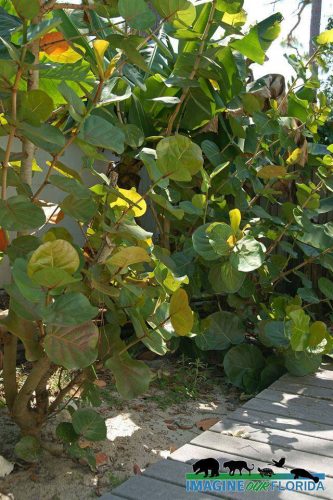Sea Grape (Coccoloba uvifera).
The Sea Grape thrives in Florida’s sandy soils. This plant tolerates windy conditions and can act as a windbreak. As well as being salt and drought tolerant, it will stabilize sand dunes while providing habitat for wildlife. This includes protection for nesting sea turtles from artificial light. Look for Sea Grapes in their natural habitat along the beach.
The Sea Grape has an unusual texture with big, round leaves which grow upright on the branches. The leaves are leathery and grow 8 to 10 inches with a reddish tint. They have red veining and some leaves will turn completely red. The female shrubs produce clusters of fruit that resemble grapes that will start out green, and ripen to purple. This plant needs a male and female to cross-pollinate and bear fruit. A Sea Grape plant with its outstretched branches will grow between 6 to 8 feet tall and wide.
The Sea Grape is a small native evergreen tropical tree that can grow as a shrub or be trained as a hedge and does best in full to partial sunlight. Although sensitive to frost, Sea Grape plants can be grown in your yard or garden. Be sure to water until established. Their fruit is very sweet and when ripe provides a tasty treat for people, birds, and squirrels. Jellies and wine are made from Sea Grapes. Consider planting a Sea Grape Plant in your Florida Native Garden.

